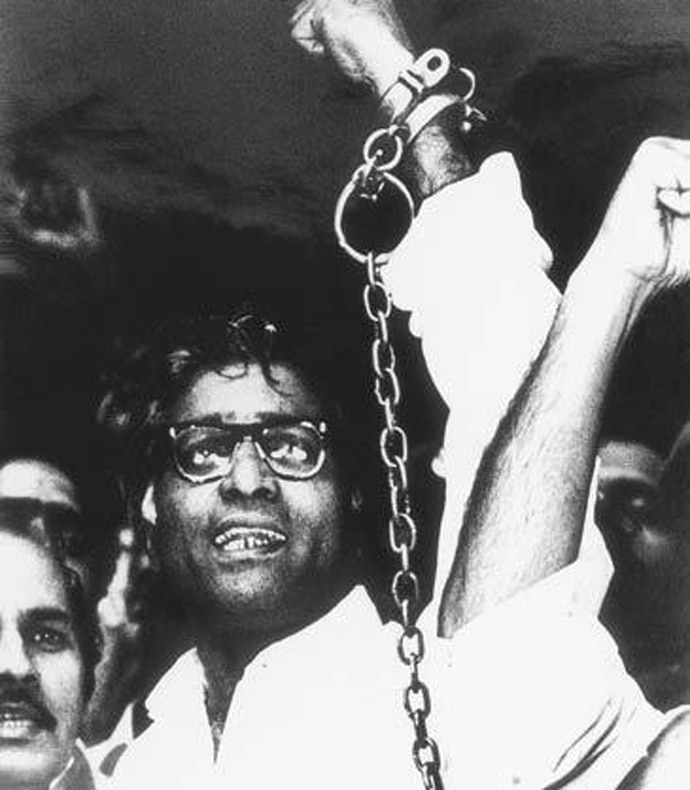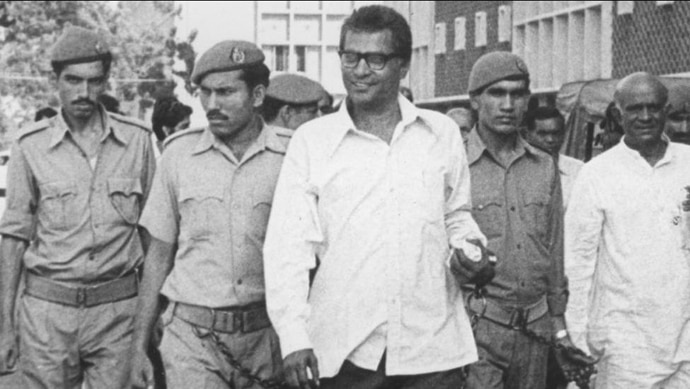Remembering George Fernandes, the original political rebel

We were on a flight to Patna in early 2005 and I was sitting next to George Fernandes. He was off to campaign in the Bihar elections: as Samata Party leader – now the JD(U) – Bihar was currently his karmabhoomi, where once it had been Mumbai. My parents knew George in the 1960s in Mumbai: apparently, a lady admirer of his (and the charismatic leader had many) lived on the ground floor of their building in the central Mumbai neighbourhood of Worli.
The 1960s was a period in the life of a city that has always fascinated me and the story of George, the boy from Mangalore who chucked up priesthood and the cloistered seminary for a life on the pavements of Mumbai, was part of city folklore.
It was a decade of great political tumult in Mumbai: the rise of the Shiv Sena and the stamping ground of the communists and socialists, this is where ideological opponents like Bal Thackeray and SA Dange jostled and battled for political space.
On the flight, we spoke of socialism and trade unionism, how George united tea-boys from South Indian cafes (many of whom were from his native Mangalore) and how he bravely led the taxi men's union. A colleague of his from the taxi union, AL Quadros, once told me that George was a Mumbai taxi-wallah at heart, "because in Mumbai, taxis and George never go to sleep!"

We also spoke of his famous entry into the Lok Sabha for the first time in 1967, as he defeated industrialist Harish Mahindra and the Congress 'boss' of Mumbai, SK Patil, to earn the title, 'George, the giant-killer'. I could see he was getting nostalgic while reviving past memories. As the plane descended, I asked him if he would like to put all those old memories to paper. 'Why not, I will be happy to share them!" he told me.
I promised to meet him soon in Delhi.
Sadly, the whirl of the news took over and I didn't meet him until several months later. By then, George had suddenly slowed down, the mind seemed to wander and the memory was fading. My preoccupation with 24x7 television and George's illness meant that we never got down to working on the promised biography.
It would have been a real page-turning book to write. Few netas, after all, can claim to have led the dramatic life of a George Fernandes. The image of him in chains being dragged away by policemen during the Emergency in 1976 became a defining symbol of protest and cemented his badge of identity as the rebellious leader with a cause. Only two years earlier, there had been another picture of George lying on the railway tracks as a nationwide bandh of the railway employees brought the entire country to a halt.

In both instances, George was pitted against Indira Gandhi, a classic political rivalry that was redolent with symbolism: Indira, the undisputed 'empress' of India versus the spirited street-fighter socialist.
Or at least, that's how George liked to pitch it: like so many of his fellow-travelers, he had an intense dislike for the Nehru-Gandhis – one that would later push him to make rather crude and uncharacteristic personal comments about Sonia Gandhi too.
In 1977, he won the Lok Sabha elections from jail, became minister for industries and found a new 'enemy' in Coca Cola. If Indira was for him an autocratic dynast, Coke was a symbol of 'American imperialism', a multinational that had to be driven out of the country. Like so much else with the Janata government of the time, it was a bad idea, mirroring a socialistic rhetoric that would keep a nation mired in poverty.
Maybe George was never cut out to be a minister: for the ultimate political pugilist, Raisina Hill was never his comfort zone. As his socialist comrade Madhu Limaye once told me, 'Even in government, George would think like he was in opposition.' Limaye and Fernandes were both formidable Parliamentarians, preferring the cut and thrust of fiery debate to the more prosaic universe of policymaking.
And yet, the George I encountered in the 1990s as a young journalist had much less of the fire and rebelliousness left in him from an earlier era. Power didn't quite seduce him (the gates of his Lutyens house were always open, he would drive a rickety Fiat and make it a point to wash his own clothes) but I fear it compromised his political soul.
By aligning with the BJP, a party which was also in a Hindutva alliance with his old foe Balasaheb's Shiv Sena, George effectively chose to bury ideology at the altar of office.
He was a genuine admirer of Vajpayee and maybe it was his affection for the former prime minister that was the glue that held his conflicted spirit together. He even assumed the role of NDA convenor but somehow, one sensed that his true identity had been left behind in a previous avatar.

And yet, even as defence minister, there was much to admire about George. He had little time for bureaucratic tardiness when it came to the treatment of jawans. The unionist in him saw the jawan as a wage labourer who was not being given his due: his repeated trips to Siachen and border units, his insistence that the babus of South Block also venture into the field, his efforts at ensuring basic equipment like snowmobiles for the soldier to fight the bitter cold at icy heights, made George a much-loved figure among the troops.
The same defence ministry saw his lowest point when he was accused of corruption in coffin procurement and pushed to resign, even boycotted by the Congress-led opposition in Parliament. The Tehelka saga only further undermined his credibility.
Somehow, it was difficult though to believe that George would be cosying up to shadowy defence dealers. Whenever I asked him a question in the many interviews we did with him in that controversial period, his answer would be typically defiant: "Let them show even one paisa of chori, I will quit public life." (a commission of inquiry would later absolve him).
The anger at his being accused of corruption seemed genuine, as was the candour in his responses, one reason why George made for such riveting television.
Hair uncombed and crumpled kurta pajama, George was unlike the well-manicured netas of today, but once in front of the camera, he was a natural headline grabber.
"China is not just our rival but our enemy number one" was one such headline which I recall. There were no scripted answers with George, no questions that were taboo, nothing was off the record. The self-image of a fearless crusader meant that he loved a joust, be it on camera or on the street.

And yet, the eternal rebel was also a nation builder. While his tenure as defence minister is highlighted, his role as railway minister in 1989 in the VP Singh government is often forgotten. It was in that brief tenure that George set up the Konkan Railway Corporation (KRC) – the dream being to connect Mumbai with his native Mangalore by a fast rail line.
He appointed E Sreedharan as the chairman of the KRC and tasked him with a mighty engineering challenge of building a railway track through an eco-sensitive coast and mountainous terrain. I remember interviewing Sreedharan in the KRC Navi Mumbai office at the time and he admitted how there was general skepticism amongst his colleagues of the project ever being completed.
Today, the Konkan railway has cut travel time and transformed the west coast region, a tribute to the vision of George and the efficacy of Sreedharan and his team.
The man who once brought the country's rail system to its knees could also help visualise a path-breaking railway line: George Fernandes was a contradictory life but also a remarkably fulfilling one.
Post-script: George Fernandes's ministerial bungalow in Delhi was always an open house, whose occupants included Myanmarese student rebels and refugees. Which is why I am pretty certain that he would have more than welcomed Rohingya refugees into his home. Which is why I also fear that in today's polarised India, George would be dubbed anti-national and seditious!

